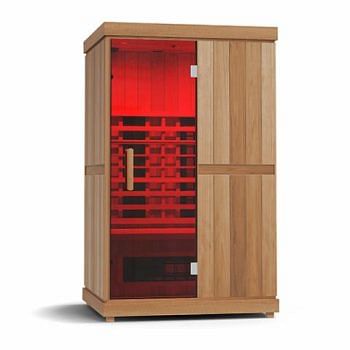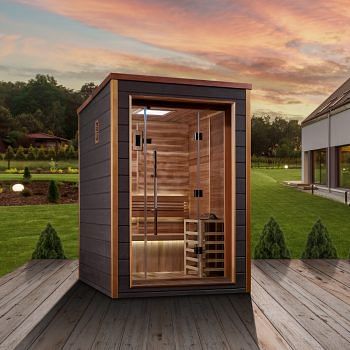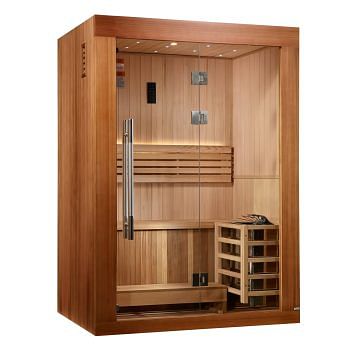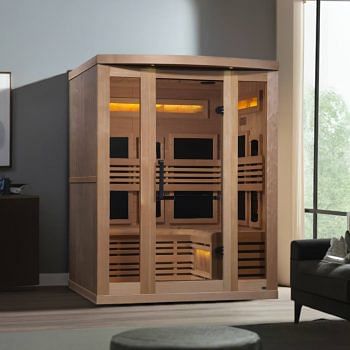Sauna Accessories
Indoor saunas bring authentic Finnish heat therapy into the comfort of your own home. Whether you’re setting up in a spare room, basement, or wellness nook, these thoughtfully designed units make it easy to unwind anytime — no backyard required. Choose from traditional steam, gentle infrared, or hybrid styles from trusted brands like Golden Designs, Finnmark, and Enlighten. Each one is crafted with beautiful, long-lasting wood and built for everyday relaxation — no matter what the weather’s doing outside.
Let’s Talk Heat: Steam vs. Infrared
Looking for that classic steam-room vibe? Or something a little gentler and quicker to heat? Indoor saunas come in two main styles — and each one offers its own kind of comfort.
Traditional Steam
This is the Finnish-style sauna most people think of: hot air, warm benches, and a splash of water on the rocks to kick up the steam. These models use electric heaters to warm the space and create that signature humid heat. It takes a little longer to get going (around 30–60 minutes), but the payoff is deep, soothing relaxation from head to toe.
If you’re looking for a model that can handle year-round use in your garden or patio, check out our outdoor saunas for weather-resistant designs built to last.
Infrared
Infrared saunas work differently. Instead of heating the air, they warm your body directly using low-EMF panels. That means faster heat-up times — usually just 15–20 minutes — and a gentler, dry heat that’s easier to handle for some users. Great for busy schedules, sore muscles, or anyone who wants to ease into their sauna routine.
Built with Beautiful, Sauna-Ready Woods
These indoor saunas are crafted with premium wood that’s made to handle the heat. You’ll find options like Canadian red cedar, clear cedar, and Baltic spruce — each offering natural moisture resistance, rich grain patterns, and a clean, relaxing aroma that fills the space once the heat kicks in.
Thanks to modular panels and plug-and-play wiring, setup is straightforward whether you're going DIY or working with a pro. From the fit and finish to the feel of the air inside, these saunas are built to look good, smell great, and last for years.
Fans of the classic Finnish steam experience may also want to browse our full range of traditional saunas for more options and sizes.
Capacity Options from Intimate to Family-Sized
Whether it’s just you or the whole crew, there’s a sauna that fits your space — and your lifestyle.
- 1–2 Person Models – Perfect for solo sessions or relaxing with a partner. These compact units are great for apartments, condos, or anyone working with limited square footage.
- 3–4 Person Options – A comfortable fit for couples or small families. Mid-size models give you extra room to stretch out without taking over your home.
- 6–8 Person Saunas – Roomy enough for group sessions, with select models offering wheelchair access and adaptive bench layouts for a more inclusive experience.
Comfort Features That Make a Difference
Today’s indoor saunas are more than just wood and heat — they’re built for comfort, convenience, and a little everyday luxury.
You’ll find features like:
- Touchscreen or remote controls
- LED mood lighting and Bluetooth audio
- Panoramic glass doors that make the space feel open and inviting
Some models also include Himalayan salt bars for added wellness, or low-to-zero EMF infrared panels for peace of mind. Ergonomic benches and built-in ventilation help keep your sessions breathable and comfortable — no matter how hot you like it.
Easy to Set Up — Wherever You Have the Space
These saunas are designed to fit right into your life — no renovations required. The modular panels go together easily, and most models can be installed in basements, spare rooms, or dedicated wellness spaces without major changes to your home.
For a distinctive look and faster, more even heating, explore our barrel saunas collection, crafted from premium cedar and perfect for outdoor spaces.
Whether you’re going for a compact 2-person unit or a roomy family-sized setup, clear instructions and plug-and-play wiring make the process straightforward. You’ll be warming up your new wellness spot in no time.
FAQs
What’s the difference between infrared and steam saunas?
Infrared saunas heat your body directly using gentle panels and typically warm up in 15–20 minutes. Steam saunas use electric heaters and water to create humid heat — the classic Finnish experience — and take 30–60 minutes to fully heat.
How much space do I need to install one at home?
1-person models can fit into small rooms, basements, or home gyms. Larger 6–8 person saunas need a bit more dedicated space, but all our models are modular — no major construction needed.
What kind of wood is best for indoor saunas?
Canadian red cedar and clear cedar are both top picks. They naturally resist moisture and smell amazing when heated. Baltic spruce is another great option if you prefer a lighter, Scandinavian look.
Can I have both infrared and steam in one sauna?
Yes! Hybrid saunas combine the best of both. Golden Designs models, for example, let you switch between a classic steam session and gentle infrared warmth — all in the same setup.
What size sauna should I get for my family?
It depends on how many people plan to use it at once.
- 1–2 person saunas are great for individuals or couples.
- 3–4 person models offer a little more room for family use.
- 6–8 person units are perfect for group sessions or if you want extra space to stretch out.



















































